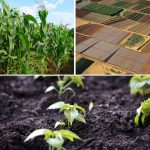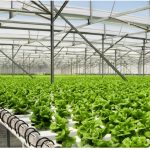Hydroponics Market Size and Forecast
According to analysts at Vantage Market Research, the Global Hydroponics Market was valued at USD 35.2 billion in 2022 and is projected to grow at a compound annual growth rate (CAGR) of 7.5% from 2023 to 2030. This rapid expansion is driven by the increasing adoption of hydroponic systems for indoor vegetable cultivation and the growing acceptance of alternative farming methods for crops such as cannabis. The legalization of marijuana in countries such as Canada, South Africa, and the Czech Republic has contributed to the acceleration of hydroponic farming techniques tailored for cannabis production.
As consumers become more aware of the health risks associated with pesticides and artificial ripening agents used in conventional farming, the demand for hydroponically grown produce is expected to rise. Hydroponic cultivation eliminates the need for these chemicals, resulting in a healthier and more nutritious product. In addition, the relatively low installation costs and operational simplicity of hydroponic systems further promote their widespread adoption. These systems, which replace soil with a nutrient-rich mineral solution, enable precise control over plant growing conditions, resulting in higher yields and reduced susceptibility to diseases.
One of the major factors driving the growth of the hydroponics market is the increasing global population, which is expected to reach 9.1 billion by 2050, according to the United Nations’ Food and Agriculture Organization (FAO). This population growth necessitates a significant increase in food production to meet demand, placing pressure on traditional farming methods. In regions where arable land and water are scarce, such as parts of Asia-Pacific and Europe, hydroponic farming offers a viable alternative to conventional agriculture, providing a solution for high-yield farming in limited spaces.
Technological advancements in climate control, nutrient delivery systems, and sensor technologies are also contributing to the expansion of the hydroponics market. Companies like SmartBee Technology, Inc. are leading the way by offering products that enable farmers to monitor and control various environmental factors in real time, including irrigation, nutrient levels, and temperature. The increasing availability of mobile apps and online education materials further supports the adoption of hydroponic farming, especially among smaller-scale and home-based growers.
Hydroponics enables the cultivation of a diverse range of crops, including tomatoes, lettuce, herbs, and exotic vegetables, in controlled indoor environments. This method of cultivation eliminates the need for pesticides and herbicides, offering a more sustainable and efficient approach to farming. Furthermore, the trend toward urbanization—where 80% of the world’s population resides in urban areas—has accelerated the shift toward innovative farming methods. Hydroponics systems can be installed in urban settings, making it possible to grow fresh produce in locations where traditional farming would be unfeasible.
In conclusion, the hydroponics market is poised for substantial growth driven by rising global food demands, environmental concerns, and technological innovation. As adoption expands across commercial agriculture, research, and home gardening sectors, the market is set to continue its upward trajectory throughout the forecast period.
Download Sample Report PDF (Including Full TOC, Table & Figures) @ https://www.vantagemarketresearch.com/hydroponics-market-2301/request-sample
Hydroponics Industry Concentration & Characteristics
The hydroponics market is characterized by a high degree of innovation and rapid growth, with numerous companies entering the sector to capitalize on the rising demand for sustainable agricultural solutions. Market growth is being driven by the need to cultivate high-quality produce in a cost-effective and resource-efficient manner. The focus on vertical farming systems, which allow crops to be grown in closely stacked layers, maximizes space and resource use, making it an attractive option for urban farming and areas with limited land availability.
Farming as a service (FaaS) is a significant trend in the hydroponics market. This model is being increasingly adopted to offer comprehensive agricultural solutions, such as turnkey hydroponic systems and managed farming services, to both large-scale commercial and small-scale consumers. There is also a notable increase in mergers and acquisitions (M&A) within the sector as companies seek to consolidate their market positions and enhance their technological capabilities. The merger of smaller players with larger firms enables the pooling of resources, as well as investments in research and development (R&D) and expansion into new geographical markets.
The market features a range of system configurations, with hydroponic farms utilizing various models, including vertical farming, deepwater culture, and nutrient film technique (NFT). These systems provide efficient alternatives to traditional soil-based farming by eliminating the need for large areas of land and reducing water usage—two key challenges in modern agriculture. As such, hydroponics systems are increasingly being seen as a solution to the global challenges of food security and resource conservation.
Hydroponics is also competing against other alternative farming methods, such as aquaponics, which combines aquaculture (fish farming) with hydroponics to create a mutually beneficial environment for both plants and fish. However, hydroponics remains the preferred method for many growers due to its simpler setup and more flexible crop options. The hydroponics industry is continually evolving, with companies focused on developing more efficient systems that require fewer resources and yield higher outputs.
The market is also fragmented by end-use applications, with hydroponics used in various sectors, including large-scale commercial farming, research institutions, and residential applications. The commercial sector represents a significant share of the market, as hydroponic systems enable farmers to cultivate crops in a controlled environment, resulting in higher yields and better-quality produce. Research and development in hydroponics is also a rapidly growing field, with numerous institutions and universities exploring the potential of hydroponic systems to enhance crop yields, minimize environmental impacts, and optimize resource utilization.
Take Action Now: Secure Your Position in the Global Hydroponics Industry Today – Purchase Now.

Based on Type Insights
Hydroponic systems can generally be categorized into two types: aggregate systems and liquid systems. The aggregate systems segment accounted for 52.5% of the hydroponics market revenue in 2023. This dominance is attributed to the ease of use and flexibility offered by these systems, which utilize solid, inert growing media such as peat, rock wool, and coconut coir to support plant growth. Aggregate systems are commonly used in drip, ebb-and-flow, and wick systems, enabling growers to tailor their setups to meet specific crop needs.
Liquid systems, which are gaining traction due to their ability to offer closed-loop nutrient delivery, are expected to grow at the highest CAGR of 14.2% from 2024 to 2030. In liquid systems, plants are submerged in a nutrient solution, eliminating the need for a solid growing medium. This system is particularly effective for leafy vegetables, such as lettuce, and accelerates plant growth by providing nutrients directly to the roots. While liquid systems offer several advantages, such as faster growth and increased yields, they also present some challenges, such as the potential for nutrient solution contamination and the need for careful monitoring of pH and nutrient levels.
Based on Crop Type Insights
The hydroponics market is also segmented by crop type, with tomatoes, lettuce, peppers, cucumbers, and herbs being the most commonly cultivated crops. Tomatoes are the leading crop in the hydroponics sector, accounting for 44.2% of market revenue in 2023. The rapid growth rate and relatively low water consumption of hydroponic tomatoes make them an ideal choice for indoor farming operations. Hydroponic tomato cultivation is particularly popular in Europe and Asia Pacific, where climate-controlled environments allow for year-round production.
The lettuce segment is expected to experience the highest growth rate during the forecast period, with a projected compound annual growth rate (CAGR) of 15.4%. Lettuce, particularly the green and red leaf varieties, is a widely consumed crop in raw form, making it a staple in hydroponic farming operations. The growing demand for fresh, locally grown produce in North America, especially from fast-food chains and households, is driving the expansion of hydroponic lettuce cultivation.
Based on Regional Insights
The Asia Pacific region dominated the hydroponics market in 2023, accounting for 35.6% of global revenue. China, in particular, has seen significant growth in the adoption of hydroponic farming, driven by urbanization, increasing demand for high-quality produce, and the need for sustainable farming methods. India is also emerging as a key player in the hydroponics market, with government initiatives promoting innovation and research in the agricultural sector.
North America is a major growth region for hydroponics, particularly in the United States and Canada. The demand for sustainable farming practices in urban areas, combined with an increasing focus on food security and environmental sustainability, is propelling the growth of hydroponic farming in the region. European countries, including France, Germany, and the Netherlands, are also witnessing an increase in the adoption of hydroponics, with a strong focus on controlled-environment agriculture (CEA) and vertical farming.
In the Middle East and Africa, the hydroponics market is experiencing growth due to the region’s increasing demand for water-efficient farming practices. Countries like South Africa are utilizing hydroponics to enhance food security, while small-scale farmers in the region are adopting hydroponics as a viable alternative to traditional farming methods.
Competitive Insights
Several key players are driving innovation in the hydroponics market, with companies focusing on advanced technologies and sustainable farming practices. AeroFarms, AmHydro, and Argus Control Systems are some of the prominent companies in the industry, each offering a range of products designed to optimize crop yields and reduce resource consumption. These companies, along with emerging players such as Freight Farms and Urban Crop Solutions, continually enhance their product offerings and expand their market presence.
AeroFarms, for example, uses a patented cloth medium to replace soil while leveraging machine learning and data analytics to monitor growing conditions and optimize nutrient delivery. AmHydro offers comprehensive hydroponic systems designed to maximize plant growth, and Freight Farms focuses on providing modular, shipping container-based hydroponic solutions.
In conclusion, the hydroponics market is highly competitive, with both established and emerging players continually innovating to meet the growing demand for sustainable, high-yield farming solutions. As technological advancements continue to shape the industry, hydroponics is expected to play a critical role in addressing the global challenges of food security, resource conservation, and environmental sustainability.
For the Hydroponics Market Research Report and updates, view the full report now!
Competitive Landscape of the Hydroponics Market
The global hydroponics market is experiencing rapid expansion and intensifying competition. This growth is driven by an increasing focus on sustainable farming practices, innovative technologies, and the rising demand for fresh, locally grown produce. The hydroponics industry is characterized by a constant cycle of product innovation, strategic partnerships, and investments, which is pushing market participants to expand their operations, enhance product offerings, and improve efficiency.
Key players in the hydroponics market include leading companies such as AeroFarms Inc. (U.S.), AmHydro (U.S.), Argus Control Systems Ltd. (Canada), Emirates Hydroponics Farms (UAE), Freight Farms (U.S.), Green Sense Farms Holdings Inc. (U.S.), LumiGrow Inc. (U.S.), Signify Holding (Netherlands), BrightFarms (U.S.), and Infarm (Germany). These companies have established themselves as significant contributors to the market through their advancements in technology, integration of sustainable practices, and development of state-of-the-art hydroponic systems that support high-quality crop production.
Recent Market Developments
Several key trends and market developments shape the competitive dynamics within the hydroponics market. AeroFarms, a global leader in indoor vertical farming, is a standout player in the industry. In February 2023, AeroFarms made a significant leap forward with the launch of AeroFarms AgX, a next-generation indoor vertical farm designed for cutting-edge, sustainable, controlled environment agriculture (CEA). This innovative farm aims to revolutionize food production in urban settings, focusing on addressing global supply chain challenges by enabling highly efficient, year-round cultivation of crops in controlled environments. AeroFarms’ emphasis on research and development (R&D) allows the company to remain at the forefront of vertical farming innovation, positioning it as a major force in the hydroponics market.
Another notable development in the industry occurred in January 2022 when Infarm, a rapidly growing urban farming company, achieved a significant milestone by becoming the first hydroponics farming system to be certified under CAN/UL 8800, the Standard for Horticultural Lighting Equipment and Systems. This certification was awarded to Infarm’s in-store vertical farming units, which are designed to grow herbs, salads, and leafy greens directly in stores or restaurants. The certification underscores Infarm’s dedication to upholding the highest safety standards in the industry while continuing to expand its presence in the urban farming sector. The company’s innovative approach to vertical farming enables efficient space utilization and offers fresh produce to consumers in urban environments, strengthening its competitive position.
Strategic mergers, acquisitions, and partnerships among key players also fuel the market’s competitiveness. Companies are increasingly collaborating to expand their product portfolios, improve technology integration, and achieve economies of scale. For example, LumiGrow Inc., a U.S.-based leader in horticultural lighting, continues to innovate with lighting solutions designed specifically for hydroponic farming. By providing energy-efficient, optimized light systems for indoor farms, LumiGrow’s products help increase crop yields and minimize energy costs, which is essential in a highly competitive market.
Strategic Collaborations and Expanding Market Reach
The industry also witnesses collaborations aimed at improving the efficiency and scalability of hydroponic systems. AmHydro, a U.S.-based company specializing in hydroponic systems, offers comprehensive solutions for hydroponic farming, including nutrient delivery systems and growing channels. The company focuses on providing tools that ensure optimal plant growth while reducing operational costs, allowing growers to achieve higher yields with fewer resources. Partnerships with research institutions, technology developers, and agricultural organizations further enhance AmHydro’s market position.
In addition to these companies, BrightFarms, Green Sense Farms Holdings, and Signify Holding (formerly Philips Lighting) are also investing heavily in the research and development of hydroponic systems. BrightFarms is recognized for its commitment to sustainable farming practices and its emphasis on growing produce locally within urban environments, thereby reducing the carbon footprint associated with food transportation. Green Sense Farms has developed advanced vertical farming systems and has secured investments to expand its production capacity, meeting the rising demand for fresh, locally grown produce.
Market Trends and Future Outlook
The competitive landscape of the hydroponics market is expected to evolve as new players enter the market and existing companies continue to innovate. The growing demand for fresh, organic produce, combined with the need for sustainable farming practices, is likely to spur further advancements in hydroponic technologies. Additionally, the integration of artificial intelligence (AI), Internet of Things (IoT) solutions, and advanced sensors into hydroponic systems will further optimize crop production, resource management, and operational efficiency, making hydroponics more appealing to both commercial growers and urban farming ventures.
As the market continues to expand, companies will also explore new opportunities in emerging regions, particularly in the Asia-Pacific, where urbanization and the demand for local food production are growing rapidly. Governments around the world are increasingly supporting hydroponic farming through subsidies, grants, and policy frameworks, providing an encouraging environment for market players to scale their operations.
Overall, the hydroponics market remains highly competitive, with ongoing technological advancements, strategic collaborations, and increased investments driving innovation and growth. As consumer demand for sustainable, high-quality produce increases, the industry is expected to continue expanding, attracting new players and prompting existing companies to refine their offerings further.
Frequently Asked Questions (FAQs)
What is hydroponics, and how does it work?
- Hydroponics is a method of growing plants without soil using a nutrient-rich solution to deliver the necessary nutrients to plant roots. Plants are supported in an inert medium, such as perlite, rock wool, or coconut coir, that holds the roots in place while the nutrient solution flows around them, providing them with all the essential elements needed for growth.
What are the main benefits of hydroponic farming?
- Hydroponic farming offers numerous advantages, including higher crop yields, reduced water usage (compared to traditional soil-based farming), the elimination of soil-borne diseases, the ability to grow in urban environments, and the reduction of pesticides and herbicides, resulting in cleaner, healthier crops.
What types of crops can be grown hydroponically?
- Many crops can be grown using hydroponic methods, including leafy greens such as lettuce and spinach, as well as herbs like basil and mint, and fruits like tomatoes, cucumbers, peppers, and strawberries. Some advanced systems also enable the cultivation of more complex crops, such as cannabis and certain fruits.
What are the different types of hydroponic systems?
- Common hydroponic systems include the Nutrient Film Technique (NFT), Deep Water Culture (DWC), aeroponics, Wick System, and Ebb and Flow (Flood and Drain) Each system has its unique method of nutrient delivery and plant support, tailored to the specific needs of the plants being cultivated.
Is hydroponics better than traditional farming?
- Hydroponics offers several advantages over traditional farming, including higher efficiency in water usage, faster plant growth, and the ability to cultivate crops in non-arable land or urban environments. However, traditional farming methods are still widely used due to cost differences and land availability. Hydroponics is particularly beneficial in regions where water is scarce or where urban farming is needed.
What is the cost of setting up a hydroponic farm?
- The cost of setting up a hydroponic system can vary significantly depending on the system’s size, type, location, and the technology used. Small-scale home hydroponics systems can be affordable, costing a few hundred dollars, but larger commercial systems for high-yield crops can range from thousands to millions of dollars.
How much water does hydroponic farming use compared to traditional farming?
- Hydroponic farming uses significantly less water than traditional soil-based farming, as water in hydroponic systems is recirculated and reused multiple times. This is in stark contrast to conventional farming, where water is often lost due to evaporation or runoff, making hydroponics a more water-efficient method of farming.
What are the challenges associated with hydroponic farming?
- While hydroponic farming offers numerous benefits, it also presents several challenges, including high initial setup costs, the need for constant monitoring and maintenance of nutrient levels and pH, the potential risk of system failure, and the requirement for specialized technical expertise to manage the systems. Additionally, some crops may require specific systems to grow successfully.
What is the market growth potential for hydroponics?
- The global hydroponics market is expected to grow at a compound annual growth rate (CAGR) of around 7.5% from 2023 to 2030. The growth is driven by factors such as the increasing demand for fresh, pesticide-free produce, the rising popularity of urban farming, government support for sustainable agricultural practices, and the growing global population.
How can I get started with hydroponics at home or as a business?
- Starting with hydroponics involves selecting the right system (based on available space and the types of crops you want to grow), purchasing the necessary equipment (like grow lights, water pumps, and nutrient solutions), and learning about plant care and maintenance. For business purposes, conducting market research, determining investment costs, and understanding local regulations and demand for hydroponic produce are essential steps for success. Beginners can also consider taking hydroponics courses or joining communities and forums for guidance.
![[Market Research Reports] – Research Google News Blog | VMR.Biz](https://www.vmr.biz/wp-content/uploads/2022/12/logo-removebg-preview.png)











